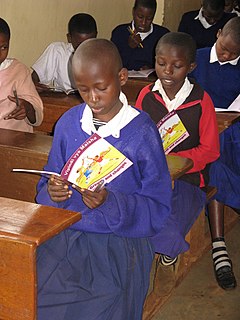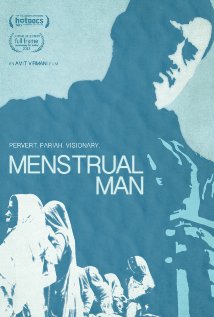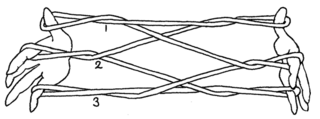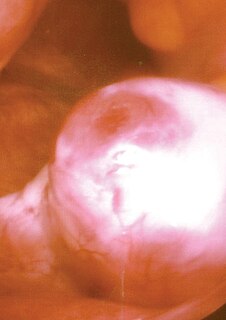 W
WThe menstrual cycle is the regular natural change that occurs in the female reproductive system that makes pregnancy possible. The cycle is required for the production of oocytes, and for the preparation of the uterus for pregnancy. The menstrual cycle occurs due to the rise and fall of estrogen. This cycle results in the thickening of the lining of the uterus, and the growth of an egg,. The egg is released from an ovary around day fourteen in the cycle; the thickened lining of the uterus provides nutrients to an embryo after implantation. If pregnancy does not occur, the lining is released in what is known as menstruation or a "period".
 W
WCulture and menstruation is about cultural aspects surrounding how societies view menstruation. A menstrual taboo is any social taboo concerned with menstruation. In some societies it involves menstruation being perceived as unclean or embarrassing, inhibiting even the mention of menstruation whether in public or in private. Many traditional religions consider menstruation ritually unclean, although anthropologists point out that the concepts 'sacred' and 'unclean' may be intimately connected.
 W
WDays for Girls (DfG) is a global movement that prepares and distributes sustainable menstrual health solutions to girls who would otherwise miss school during their monthly periods. The nonprofit organization was founded in 2008 by American woman Celeste Mergens. After visiting an orphanage in Nairobi, Kenya, she discovered that menstruating girls stayed in their dormitories for days, sitting on cardboard to absorb their flow, because they could not afford feminine hygiene products. Her first response was to organize donations of disposable sanitary pads, but she realized that this was not a sustainable solution — and the girls had no way to dispose of used pads. She then developed the idea of creating washable, reusable pads and providing the girls with a personal kit of all they would need to continue their schooling with hygiene and dignity. By 2018, the DfG Kits and health education programs had reached more than one million girls and women in over 100 countries.
 W
WDecidualization is a process that results in significant changes to cells of the endometrium in preparation for, and during, pregnancy. This includes morphological and functional changes to endometrial stromal cells (ESCs), the presence of decidual white blood cells (leukocytes), and vascular changes to maternal arteries. The sum of these changes results in the endometrium changing into a structure called the decidua. In humans, the decidua is shed during the third phase of birth.
 W
WDecidualization is a process that results in significant changes to cells of the endometrium in preparation for, and during, pregnancy. This includes morphological and functional changes to endometrial stromal cells (ESCs), the presence of decidual white blood cells (leukocytes), and vascular changes to maternal arteries. The sum of these changes results in the endometrium changing into a structure called the decidua. In humans, the decidua is shed during the third phase of birth.
 W
WEndometriosis is a condition in which cells similar to those in the endometrium, the layer of tissue that normally covers the inside of the uterus, grow outside the uterus. Most often this is on the ovaries, fallopian tubes, and tissue around the uterus and ovaries; however, in rare cases it may also occur in other parts of the body. The main symptoms are pelvic pain and infertility. Nearly half of those affected have chronic pelvic pain, while in 70% pain occurs during menstruation. Pain during sexual intercourse is also common. Infertility occurs in up to half of affected individuals. Less common symptoms include urinary or bowel symptoms. About 25% of individuals have no symptoms and 85% of those seen with infertility in a tertiary center have no pain. Endometriosis can have both social and psychological effects.
 W
WThe hypothalamic–pituitary–gonadal axis refers to the hypothalamus, pituitary gland, and gonadal glands as if these individual endocrine glands were a single entity. Because these glands often act in concert, physiologists and endocrinologists find it convenient and descriptive to speak of them as a single system.
 W
WThe luteal phase is the latter phase of the menstrual cycle or the earlier phase of the estrous cycle. It begins with the formation of the corpus luteum and ends in either pregnancy or luteolysis. The main hormone associated with this stage is progesterone, which is significantly higher during the luteal phase than other phases of the cycle. Another is the endocannabinoid anandamide AEA, where the lowest plasma AEA level is observed in the luteal phase. The opposite of the luteal phase, the rest of the two weeks, is called the follicular phase.
 W
WThe traditional Mayas generally assume the Moon to be female, and the Moon's perceived phases are accordingly conceived as the stages of a woman's life. The Maya moon goddess wields great influence in many areas. Being in the image of a woman, she is associated with sexuality and procreation, fertility and growth, not only of human beings, but also of the vegetation and the crops. Since growth can also cause all sorts of ailments, the moon goddess is also a goddess of disease. Everywhere in Mesoamerica, including the Mayan area, she is specifically associated with water, be it wells, rainfall, or the rainy season. In the codices, she has a terrestrial counterpart in goddess I.
 W
WA menstrual cup is a feminine hygiene device which is inserted into the vagina during menstruation. Its purpose is to collect menstrual fluid and prevent its leaking onto clothes. Menstrual cups are usually made of flexible medical grade silicone, latex, or a thermoplastic isomer. They are shaped like a bell with a stem. The stem is used for insertion and removal. The bell-shaped cup seals against the vaginal wall just below the cervix. Every 4–12 hours, the cup is removed, emptied, rinsed, and reinserted. After each period, the cup requires cleaning.
 W
WMenstrual hygiene management (MHM) or menstrual health and hygiene (MHH) is about access to menstrual hygiene products to absorb or collect menstrual blood, privacy to change the materials, and access to facilities to dispose of used menstrual management materials. It can also include the "broader systemic factors that link menstruation with health, well-being, gender equality, education, equity, empowerment, and rights". Menstrual hygiene management can be particularly challenging for girls and women in developing countries, where clean water and toilet facilities are often inadequate. Menstrual waste is largely ignored in schools in developing countries, despite it being a significant problem. Menstruation can be a barrier to education for many girls, as a lack of effective sanitary products restricts girls' involvement in educational and social activities.
 W
WMenstrual Man is a 2013 documentary film by Amit Virmani. The film tells the story of Arunachalam Muruganantham, an Indian social entrepreneur and inventor whose machines enable rural women to manufacture low-cost sanitary pads for their communities. It premiered at the 2013 Full Frame Documentary Film Festival, and was voted a Top Ten Audience Favourite at both Hot Docs and IDFA the same year. The film was nominated for Best Feature Documentary at the Asia Pacific Screen Awards.
 W
WMenstrual synchrony, also called the McClintock effect, is an alleged process whereby women who begin living together in close proximity experience their menstrual cycle onsets becoming more synchronized together in time than when previously living apart. "For example, the distribution of onsets of seven female lifeguards was scattered at the beginning of the summer, but after 3 months spent together, the onset of all seven cycles fell within a 4-day period."
 W
WChhaupadi is a form of menstrual taboo which prohibits Hindu women and girls from participating in normal family activities while menstruating, as they are considered "impure". Chhaupadi is said to be practiced primarily in the western part of Nepal, but the same is true for city dwellers also.
 W
WMenstruation, also known as a period or monthly, is the regular discharge of blood and mucosal tissue from the inner lining of the uterus through the vagina. The first period usually begins between twelve and fifteen years of age, a point in time known as menarche. However, periods may occasionally start as young as eight years old and still be considered normal. The average age of the first period is generally later in the developing world, and earlier in the developed world. The typical length of time between the first day of one period and the first day of the next is 21 to 45 days in young women, and 21 to 31 days in adults. Bleeding usually lasts around 2 to 7 days. Menstruation stops occurring after menopause, which usually occurs between 45 and 55 years of age. Periods also stop during pregnancy and typically do not resume during the initial months of breastfeeding.
 W
WA menstruation hut is a place of seclusion or isolation used by certain cultures with strong menstrual taboos. The same or a similar structure may be used for childbirth and postpartum confinement, based on beliefs around ritual impurity. These huts are usually built near the family home, have small doors, and are often dilapidated, with poor sanitation and ventilation, and no windows. The Nepali version, the Chhaupadi, is probably the best-known example, but cultural attitudes towards menstruation around the world mean that these huts exist, or existed until recently, in other places as well. The use of menstrual huts continues to be the cause of death, from exposure, dehydration, snake bite, smoke inhalation, and so on. The use of these huts is illegal in some places.
 W
WThe ḥaiḍ is the religious state of menstruation in Islam. Menstruation relates to various purity related restrictions in Islamic sexual jurisprudence.
 W
WMenstrupedia comic is a guide to educate people around the world on menstruation. It was started by Aditi Gupta. Tuhin Paul and Rajat Mittal. Menstrupedia aims to help people understand the process of puberty in women and men. It seeks to destroy myths around menstruation and to normalise the biological process.
 W
WThe Myna Mahila Foundation (MMF) is an Indian organization which empowers women by encouraging discussion of taboo subjects such as menstruation, and by setting up workshops to produce low-cost sanitary protection to enable girls to stay in school. It was founded by Suhani Jalota in 2015 while she was studying at Duke University.
 W
WOvulation is the release of eggs from the ovaries. In women, this event occurs when the ovarian follicles rupture and release the secondary oocyte ovarian cells. After ovulation, during the luteal phase, the egg will be available to be fertilized by sperm. In addition, the uterine lining (endometrium) is thickened to be able to receive a fertilized egg. If no conception occurs, the uterine lining as well as blood will be shed during menstruation.
 W
WPeriod. End of Sentence. is a 2018 documentary short film directed by Rayka Zehtabchi about Indian women leading a quiet sexual revolution. The film stars Arunachalam Muruganantham, Shabana Khan, Gouri Choudari, Ajeya, and Anita. The documentary short follows a group of local women in Hapur, India, as they learn how to operate a machine that makes low-cost, biodegradable sanitary pads, which they sell to other women at affordable prices. This not only helps to improve feminine hygiene by providing access to basic products but also supports and empowers the women to shed the taboos in India surrounding menstruation – all while contributing to the economic future of their community. The film is inspired from the life of Arunachalam Muruganantham, a social activist from Tamil Nadu, India.
 W
WHalf sari function or Langa Voni Telugu: లంగా ఓణి, Pavadai Dhavani Tamil: பாவாடை, Langa Davani Kannada: ಲಂಗ ದಾವಣಿ. In South India, the Ritu Kala Samskara ceremony or Ritushuddhi is an Indian Hindu ceremony performed when a girl wears a sari for the first time. It is the celebration of when a girl's rite of passage after menarche and she is deemed a young woman both physically and spiritually. Langa voni is traditional clothing for unmarried girls in South India.
 W
WA sanitary napkin, sanitary towel, sanitary pad, menstrual pad, or pad is an absorbent item worn in the underwear when menstruating, bleeding after giving birth, recovering from gynecologic surgery, experiencing a miscarriage or abortion, or in any other situation where it is necessary to absorb a flow of blood from the vagina. A menstrual pad is a type of feminine hygiene product that is worn externally, unlike tampons and menstrual cups which are worn inside the vagina. The pad has to be changed several times in 24 hours depending on whether menstrual flow is heavy or light.
 W
WA Silky Cup is a "Clinically Tested" feminine hygiene product which is made of thermoplastic elastomer (TPE), shaped like a bell and is flexible. It is worn inside the vagina during menstruation to catch menstrual fluid (blood). About every 4–12 hours, the menstruating woman removes the Silky cup from her vagina, empties the collected menstrual blood into a toilet or sink, washes the cup under running water and inserts it again. At the end of the monthly period, the cup can be sterilized, usually by boiling in water. Unlike tampons and pads, the cup collects menstrual fluid rather than absorbing it.
 W
WThe Story of Menstruation is a 1946 10-minute American animated film produced by Walt Disney Productions. It was commissioned by the International Cello-Cotton Company and was shown in a non-theatrical release to approximately 105 million American students in health education classes. In 2015, it was selected for preservation in the National Film Registry.
 W
WA tampon is a menstrual product designed to absorb blood and vaginal secretions by insertion into the vagina during menstruation. Unlike a pad, it is placed internally, inside of the vaginal canal. Once inserted correctly, a tampon is held in place by the vagina and expands as it soaks up menstrual blood. In addition to menstrual blood, the tampon also absorbs the vagina's natural lubrication and bacteria, which can change the normal pH, increasing the risk of infections from the bacterium Staphylococcus aureus, which can lead to toxic shock syndrome (TSS). TSS is a rare, but life-threatening infection that requires immediate medical attention.
 W
WA yoetzet halacha is a woman certified to serve as an advisor to women with questions regarding taharat hamishpacha.